Sociological Analysis: Intersections of Race and Class Theories
VerifiedAdded on 2022/09/15
|8
|1577
|25
Essay
AI Summary
This essay delves into the complex intersections of race and class, examining these concepts through the lenses of functionalism and conflict theory. It begins with an introduction to the various social relations that shape inequalities, highlighting the experiences of the Maori people as a case study for marginalization. The essay then provides a detailed overview of functionalism, exploring its perspective on race and class, including the positive and negative aspects of racial inequalities and class discrimination. Subsequently, it contrasts functionalism with conflict theory, analyzing how power struggles and inequalities between racial and class groups are viewed. The paper concludes by emphasizing the relevance of these theories to the Kaupapa statement and the Maori community, highlighting the interplay of race, class, and culture, and the application of these theories to real-world scenarios. The essay avoids dogmatism, presenting a balanced view of both theories and their respective strengths and weaknesses.
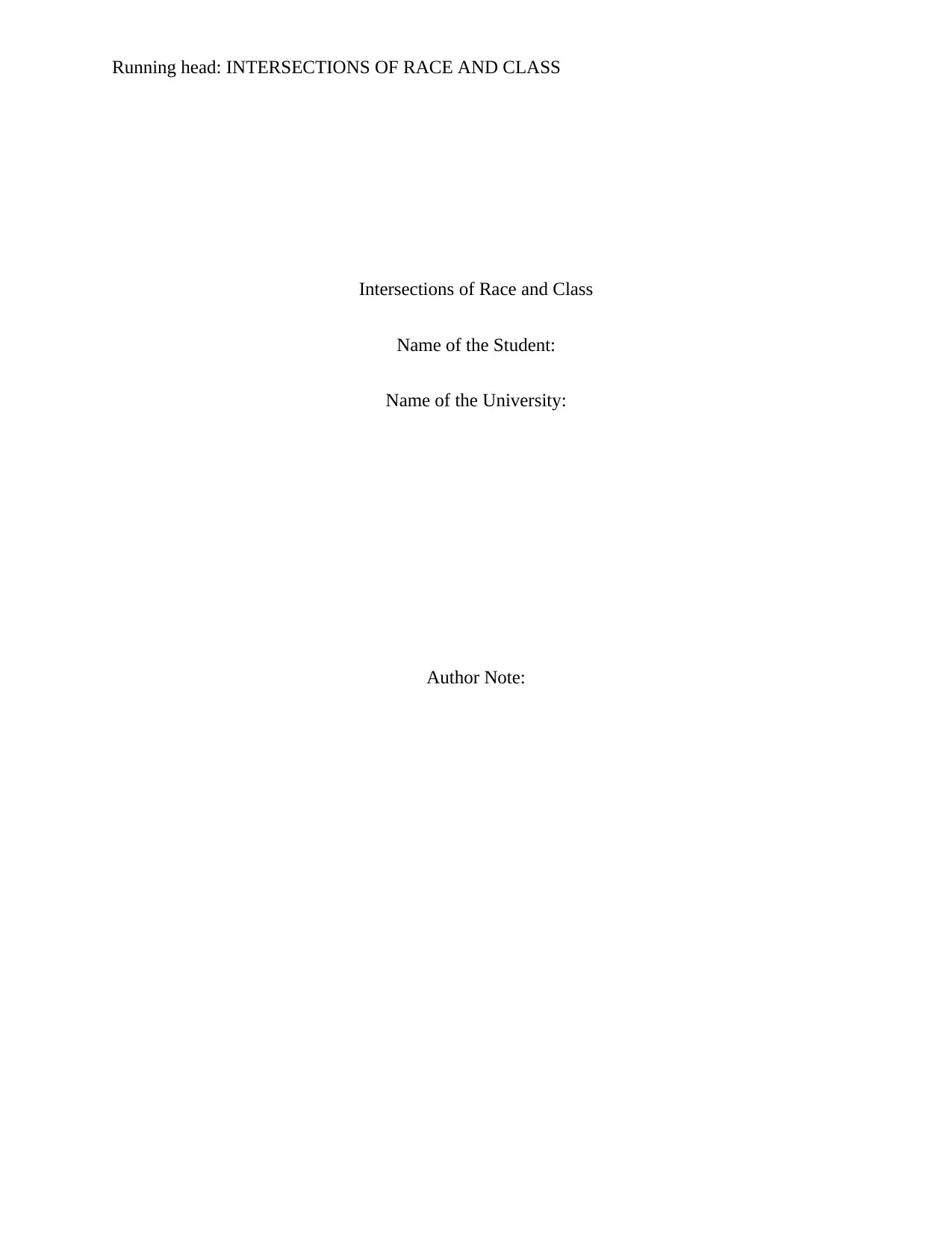
Running head: INTERSECTIONS OF RACE AND CLASS
Intersections of Race and Class
Name of the Student:
Name of the University:
Author Note:
Intersections of Race and Class
Name of the Student:
Name of the University:
Author Note:
Paraphrase This Document
Need a fresh take? Get an instant paraphrase of this document with our AI Paraphraser
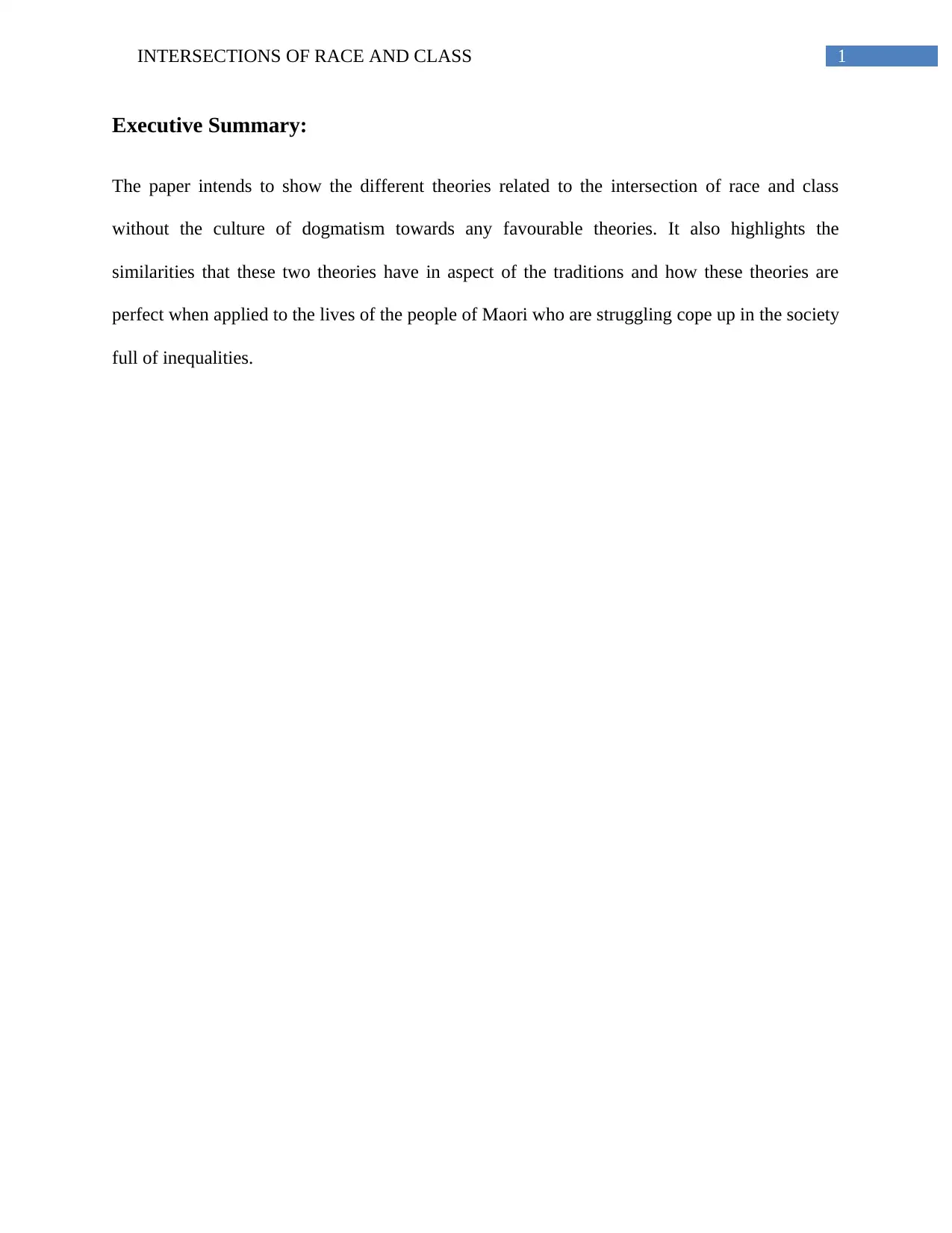
1INTERSECTIONS OF RACE AND CLASS
Executive Summary:
The paper intends to show the different theories related to the intersection of race and class
without the culture of dogmatism towards any favourable theories. It also highlights the
similarities that these two theories have in aspect of the traditions and how these theories are
perfect when applied to the lives of the people of Maori who are struggling cope up in the society
full of inequalities.
Executive Summary:
The paper intends to show the different theories related to the intersection of race and class
without the culture of dogmatism towards any favourable theories. It also highlights the
similarities that these two theories have in aspect of the traditions and how these theories are
perfect when applied to the lives of the people of Maori who are struggling cope up in the society
full of inequalities.
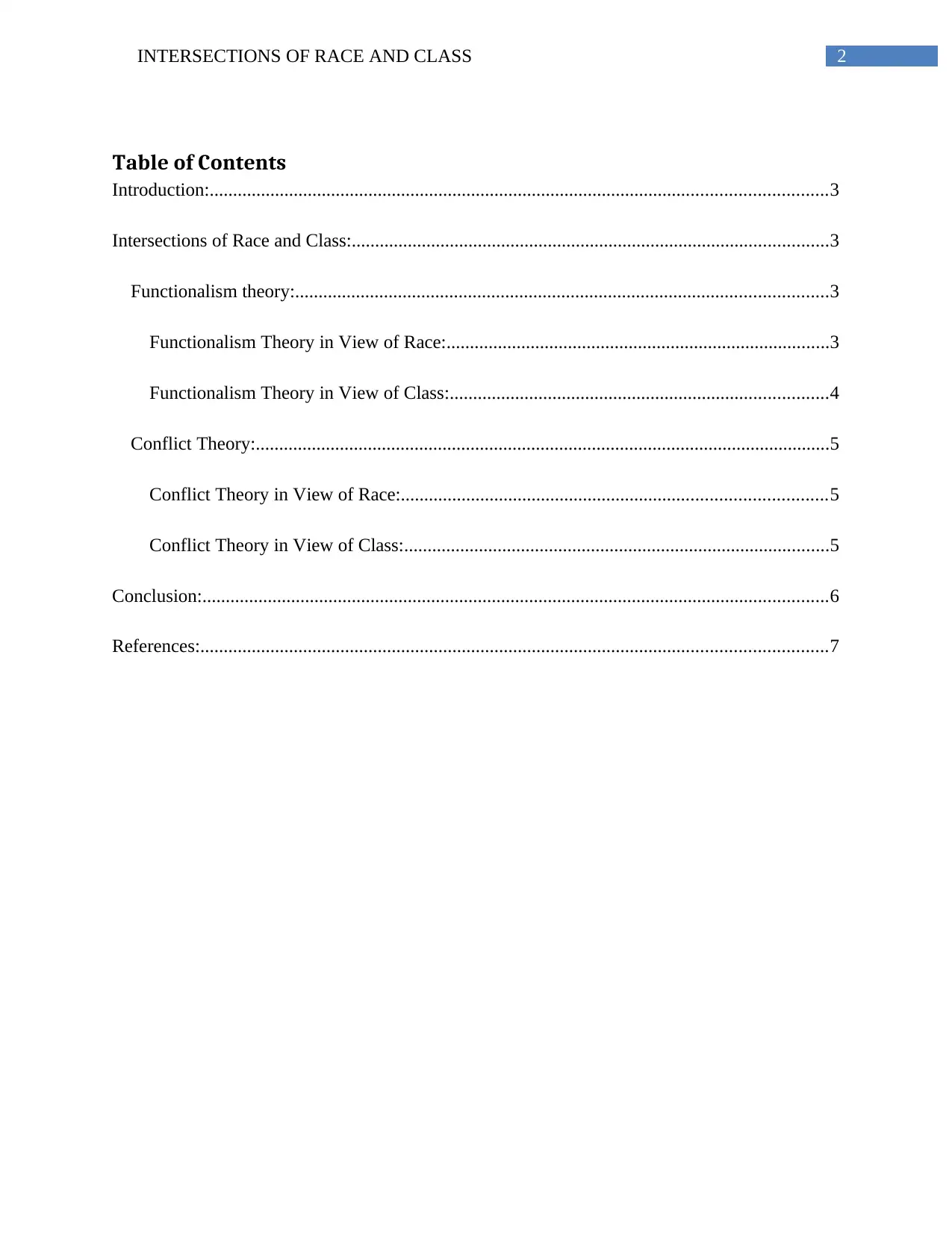
2INTERSECTIONS OF RACE AND CLASS
Table of Contents
Introduction:....................................................................................................................................3
Intersections of Race and Class:......................................................................................................3
Functionalism theory:..................................................................................................................3
Functionalism Theory in View of Race:..................................................................................3
Functionalism Theory in View of Class:.................................................................................4
Conflict Theory:...........................................................................................................................5
Conflict Theory in View of Race:...........................................................................................5
Conflict Theory in View of Class:...........................................................................................5
Conclusion:......................................................................................................................................6
References:......................................................................................................................................7
Table of Contents
Introduction:....................................................................................................................................3
Intersections of Race and Class:......................................................................................................3
Functionalism theory:..................................................................................................................3
Functionalism Theory in View of Race:..................................................................................3
Functionalism Theory in View of Class:.................................................................................4
Conflict Theory:...........................................................................................................................5
Conflict Theory in View of Race:...........................................................................................5
Conflict Theory in View of Class:...........................................................................................5
Conclusion:......................................................................................................................................6
References:......................................................................................................................................7
⊘ This is a preview!⊘
Do you want full access?
Subscribe today to unlock all pages.

Trusted by 1+ million students worldwide
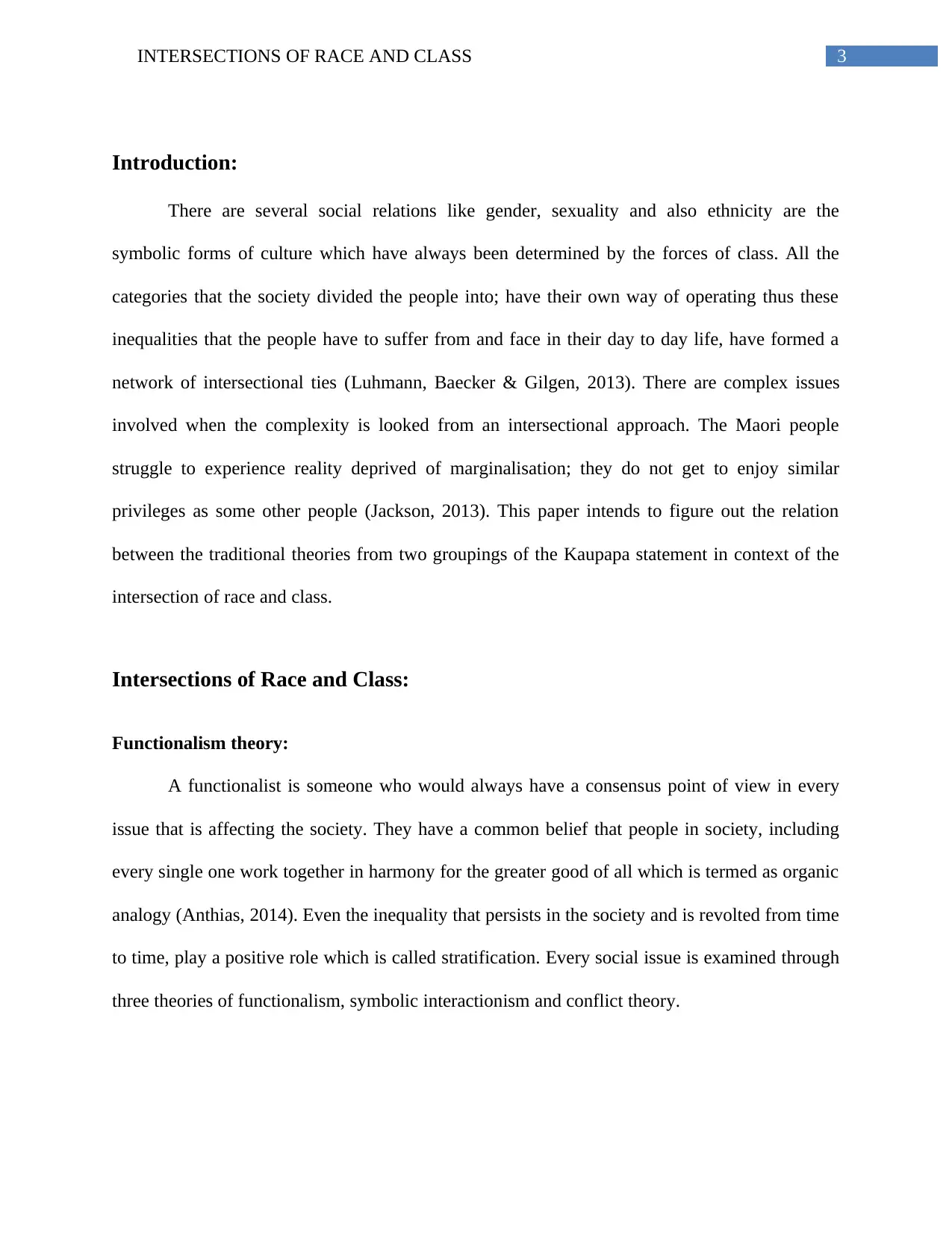
3INTERSECTIONS OF RACE AND CLASS
Introduction:
There are several social relations like gender, sexuality and also ethnicity are the
symbolic forms of culture which have always been determined by the forces of class. All the
categories that the society divided the people into; have their own way of operating thus these
inequalities that the people have to suffer from and face in their day to day life, have formed a
network of intersectional ties (Luhmann, Baecker & Gilgen, 2013). There are complex issues
involved when the complexity is looked from an intersectional approach. The Maori people
struggle to experience reality deprived of marginalisation; they do not get to enjoy similar
privileges as some other people (Jackson, 2013). This paper intends to figure out the relation
between the traditional theories from two groupings of the Kaupapa statement in context of the
intersection of race and class.
Intersections of Race and Class:
Functionalism theory:
A functionalist is someone who would always have a consensus point of view in every
issue that is affecting the society. They have a common belief that people in society, including
every single one work together in harmony for the greater good of all which is termed as organic
analogy (Anthias, 2014). Even the inequality that persists in the society and is revolted from time
to time, play a positive role which is called stratification. Every social issue is examined through
three theories of functionalism, symbolic interactionism and conflict theory.
Introduction:
There are several social relations like gender, sexuality and also ethnicity are the
symbolic forms of culture which have always been determined by the forces of class. All the
categories that the society divided the people into; have their own way of operating thus these
inequalities that the people have to suffer from and face in their day to day life, have formed a
network of intersectional ties (Luhmann, Baecker & Gilgen, 2013). There are complex issues
involved when the complexity is looked from an intersectional approach. The Maori people
struggle to experience reality deprived of marginalisation; they do not get to enjoy similar
privileges as some other people (Jackson, 2013). This paper intends to figure out the relation
between the traditional theories from two groupings of the Kaupapa statement in context of the
intersection of race and class.
Intersections of Race and Class:
Functionalism theory:
A functionalist is someone who would always have a consensus point of view in every
issue that is affecting the society. They have a common belief that people in society, including
every single one work together in harmony for the greater good of all which is termed as organic
analogy (Anthias, 2014). Even the inequality that persists in the society and is revolted from time
to time, play a positive role which is called stratification. Every social issue is examined through
three theories of functionalism, symbolic interactionism and conflict theory.
Paraphrase This Document
Need a fresh take? Get an instant paraphrase of this document with our AI Paraphraser
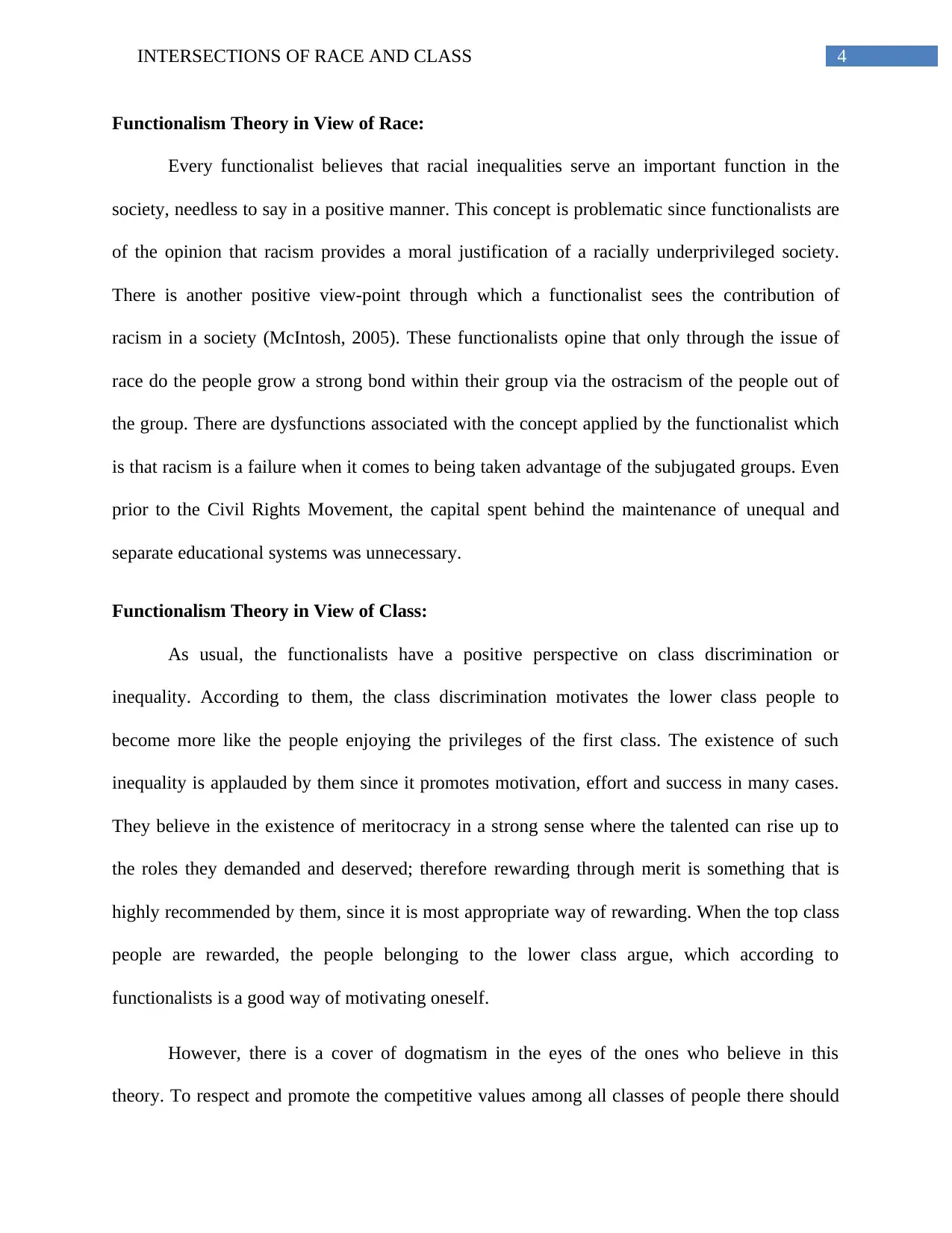
4INTERSECTIONS OF RACE AND CLASS
Functionalism Theory in View of Race:
Every functionalist believes that racial inequalities serve an important function in the
society, needless to say in a positive manner. This concept is problematic since functionalists are
of the opinion that racism provides a moral justification of a racially underprivileged society.
There is another positive view-point through which a functionalist sees the contribution of
racism in a society (McIntosh, 2005). These functionalists opine that only through the issue of
race do the people grow a strong bond within their group via the ostracism of the people out of
the group. There are dysfunctions associated with the concept applied by the functionalist which
is that racism is a failure when it comes to being taken advantage of the subjugated groups. Even
prior to the Civil Rights Movement, the capital spent behind the maintenance of unequal and
separate educational systems was unnecessary.
Functionalism Theory in View of Class:
As usual, the functionalists have a positive perspective on class discrimination or
inequality. According to them, the class discrimination motivates the lower class people to
become more like the people enjoying the privileges of the first class. The existence of such
inequality is applauded by them since it promotes motivation, effort and success in many cases.
They believe in the existence of meritocracy in a strong sense where the talented can rise up to
the roles they demanded and deserved; therefore rewarding through merit is something that is
highly recommended by them, since it is most appropriate way of rewarding. When the top class
people are rewarded, the people belonging to the lower class argue, which according to
functionalists is a good way of motivating oneself.
However, there is a cover of dogmatism in the eyes of the ones who believe in this
theory. To respect and promote the competitive values among all classes of people there should
Functionalism Theory in View of Race:
Every functionalist believes that racial inequalities serve an important function in the
society, needless to say in a positive manner. This concept is problematic since functionalists are
of the opinion that racism provides a moral justification of a racially underprivileged society.
There is another positive view-point through which a functionalist sees the contribution of
racism in a society (McIntosh, 2005). These functionalists opine that only through the issue of
race do the people grow a strong bond within their group via the ostracism of the people out of
the group. There are dysfunctions associated with the concept applied by the functionalist which
is that racism is a failure when it comes to being taken advantage of the subjugated groups. Even
prior to the Civil Rights Movement, the capital spent behind the maintenance of unequal and
separate educational systems was unnecessary.
Functionalism Theory in View of Class:
As usual, the functionalists have a positive perspective on class discrimination or
inequality. According to them, the class discrimination motivates the lower class people to
become more like the people enjoying the privileges of the first class. The existence of such
inequality is applauded by them since it promotes motivation, effort and success in many cases.
They believe in the existence of meritocracy in a strong sense where the talented can rise up to
the roles they demanded and deserved; therefore rewarding through merit is something that is
highly recommended by them, since it is most appropriate way of rewarding. When the top class
people are rewarded, the people belonging to the lower class argue, which according to
functionalists is a good way of motivating oneself.
However, there is a cover of dogmatism in the eyes of the ones who believe in this
theory. To respect and promote the competitive values among all classes of people there should
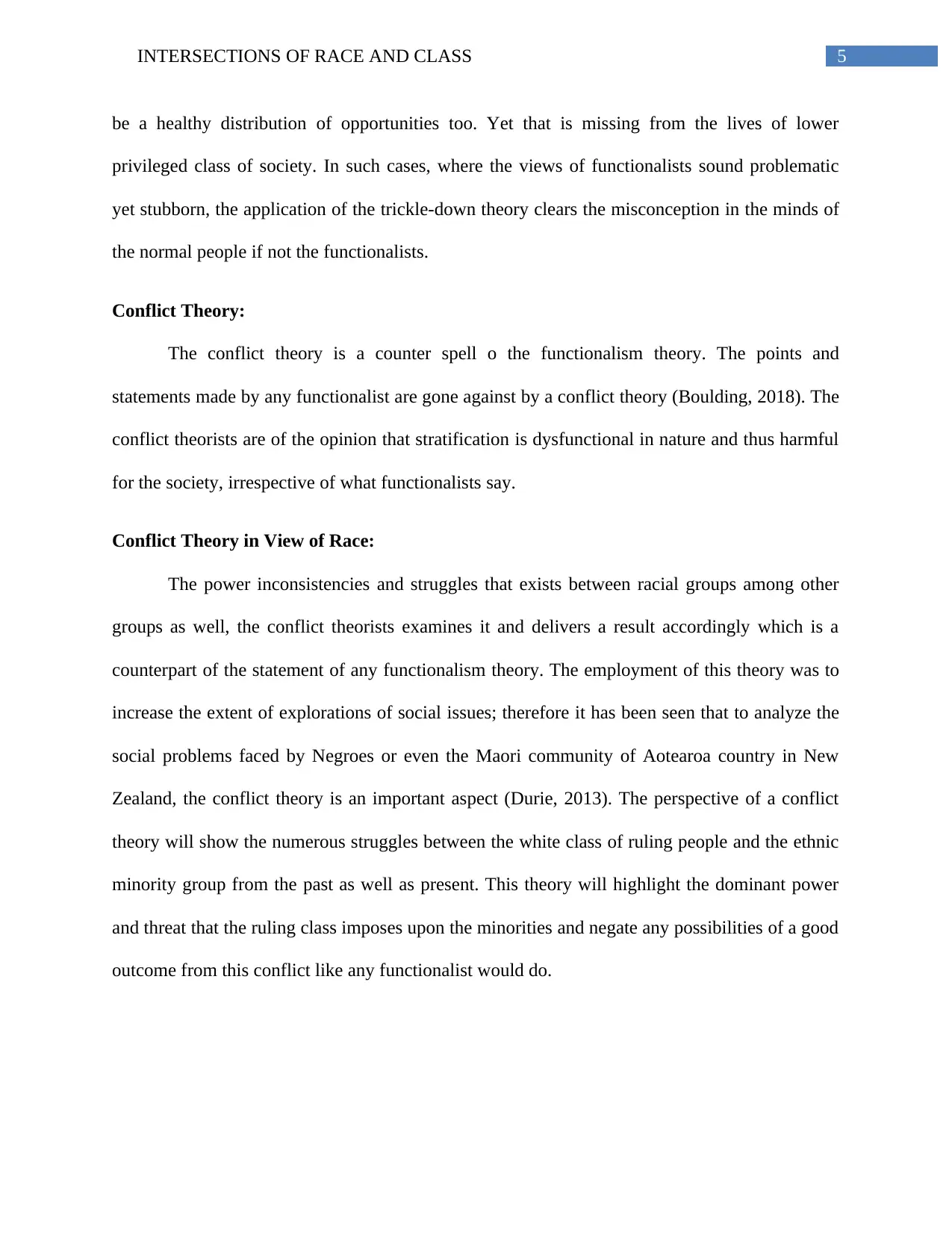
5INTERSECTIONS OF RACE AND CLASS
be a healthy distribution of opportunities too. Yet that is missing from the lives of lower
privileged class of society. In such cases, where the views of functionalists sound problematic
yet stubborn, the application of the trickle-down theory clears the misconception in the minds of
the normal people if not the functionalists.
Conflict Theory:
The conflict theory is a counter spell o the functionalism theory. The points and
statements made by any functionalist are gone against by a conflict theory (Boulding, 2018). The
conflict theorists are of the opinion that stratification is dysfunctional in nature and thus harmful
for the society, irrespective of what functionalists say.
Conflict Theory in View of Race:
The power inconsistencies and struggles that exists between racial groups among other
groups as well, the conflict theorists examines it and delivers a result accordingly which is a
counterpart of the statement of any functionalism theory. The employment of this theory was to
increase the extent of explorations of social issues; therefore it has been seen that to analyze the
social problems faced by Negroes or even the Maori community of Aotearoa country in New
Zealand, the conflict theory is an important aspect (Durie, 2013). The perspective of a conflict
theory will show the numerous struggles between the white class of ruling people and the ethnic
minority group from the past as well as present. This theory will highlight the dominant power
and threat that the ruling class imposes upon the minorities and negate any possibilities of a good
outcome from this conflict like any functionalist would do.
be a healthy distribution of opportunities too. Yet that is missing from the lives of lower
privileged class of society. In such cases, where the views of functionalists sound problematic
yet stubborn, the application of the trickle-down theory clears the misconception in the minds of
the normal people if not the functionalists.
Conflict Theory:
The conflict theory is a counter spell o the functionalism theory. The points and
statements made by any functionalist are gone against by a conflict theory (Boulding, 2018). The
conflict theorists are of the opinion that stratification is dysfunctional in nature and thus harmful
for the society, irrespective of what functionalists say.
Conflict Theory in View of Race:
The power inconsistencies and struggles that exists between racial groups among other
groups as well, the conflict theorists examines it and delivers a result accordingly which is a
counterpart of the statement of any functionalism theory. The employment of this theory was to
increase the extent of explorations of social issues; therefore it has been seen that to analyze the
social problems faced by Negroes or even the Maori community of Aotearoa country in New
Zealand, the conflict theory is an important aspect (Durie, 2013). The perspective of a conflict
theory will show the numerous struggles between the white class of ruling people and the ethnic
minority group from the past as well as present. This theory will highlight the dominant power
and threat that the ruling class imposes upon the minorities and negate any possibilities of a good
outcome from this conflict like any functionalist would do.
⊘ This is a preview!⊘
Do you want full access?
Subscribe today to unlock all pages.

Trusted by 1+ million students worldwide
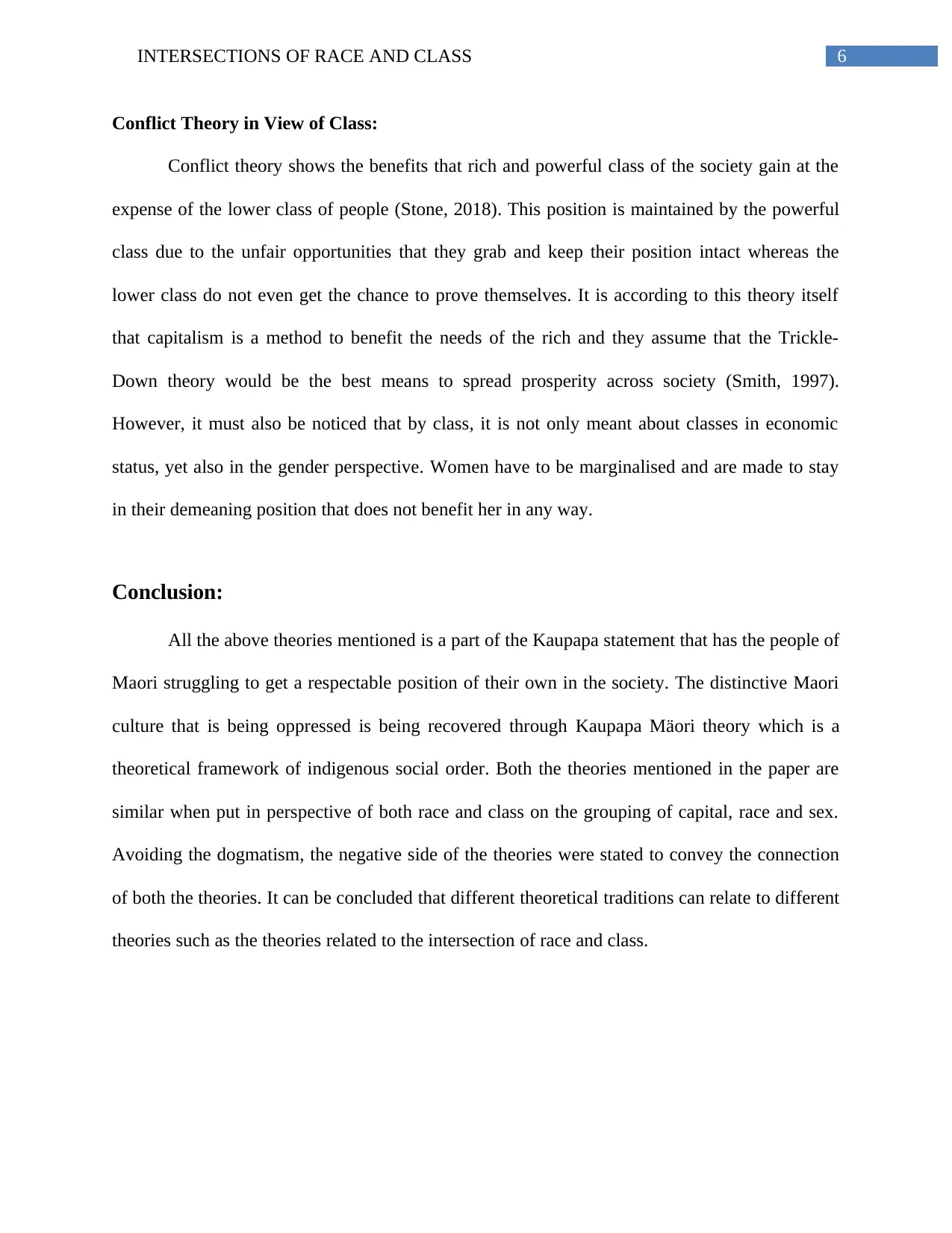
6INTERSECTIONS OF RACE AND CLASS
Conflict Theory in View of Class:
Conflict theory shows the benefits that rich and powerful class of the society gain at the
expense of the lower class of people (Stone, 2018). This position is maintained by the powerful
class due to the unfair opportunities that they grab and keep their position intact whereas the
lower class do not even get the chance to prove themselves. It is according to this theory itself
that capitalism is a method to benefit the needs of the rich and they assume that the Trickle-
Down theory would be the best means to spread prosperity across society (Smith, 1997).
However, it must also be noticed that by class, it is not only meant about classes in economic
status, yet also in the gender perspective. Women have to be marginalised and are made to stay
in their demeaning position that does not benefit her in any way.
Conclusion:
All the above theories mentioned is a part of the Kaupapa statement that has the people of
Maori struggling to get a respectable position of their own in the society. The distinctive Maori
culture that is being oppressed is being recovered through Kaupapa Mäori theory which is a
theoretical framework of indigenous social order. Both the theories mentioned in the paper are
similar when put in perspective of both race and class on the grouping of capital, race and sex.
Avoiding the dogmatism, the negative side of the theories were stated to convey the connection
of both the theories. It can be concluded that different theoretical traditions can relate to different
theories such as the theories related to the intersection of race and class.
Conflict Theory in View of Class:
Conflict theory shows the benefits that rich and powerful class of the society gain at the
expense of the lower class of people (Stone, 2018). This position is maintained by the powerful
class due to the unfair opportunities that they grab and keep their position intact whereas the
lower class do not even get the chance to prove themselves. It is according to this theory itself
that capitalism is a method to benefit the needs of the rich and they assume that the Trickle-
Down theory would be the best means to spread prosperity across society (Smith, 1997).
However, it must also be noticed that by class, it is not only meant about classes in economic
status, yet also in the gender perspective. Women have to be marginalised and are made to stay
in their demeaning position that does not benefit her in any way.
Conclusion:
All the above theories mentioned is a part of the Kaupapa statement that has the people of
Maori struggling to get a respectable position of their own in the society. The distinctive Maori
culture that is being oppressed is being recovered through Kaupapa Mäori theory which is a
theoretical framework of indigenous social order. Both the theories mentioned in the paper are
similar when put in perspective of both race and class on the grouping of capital, race and sex.
Avoiding the dogmatism, the negative side of the theories were stated to convey the connection
of both the theories. It can be concluded that different theoretical traditions can relate to different
theories such as the theories related to the intersection of race and class.
Paraphrase This Document
Need a fresh take? Get an instant paraphrase of this document with our AI Paraphraser
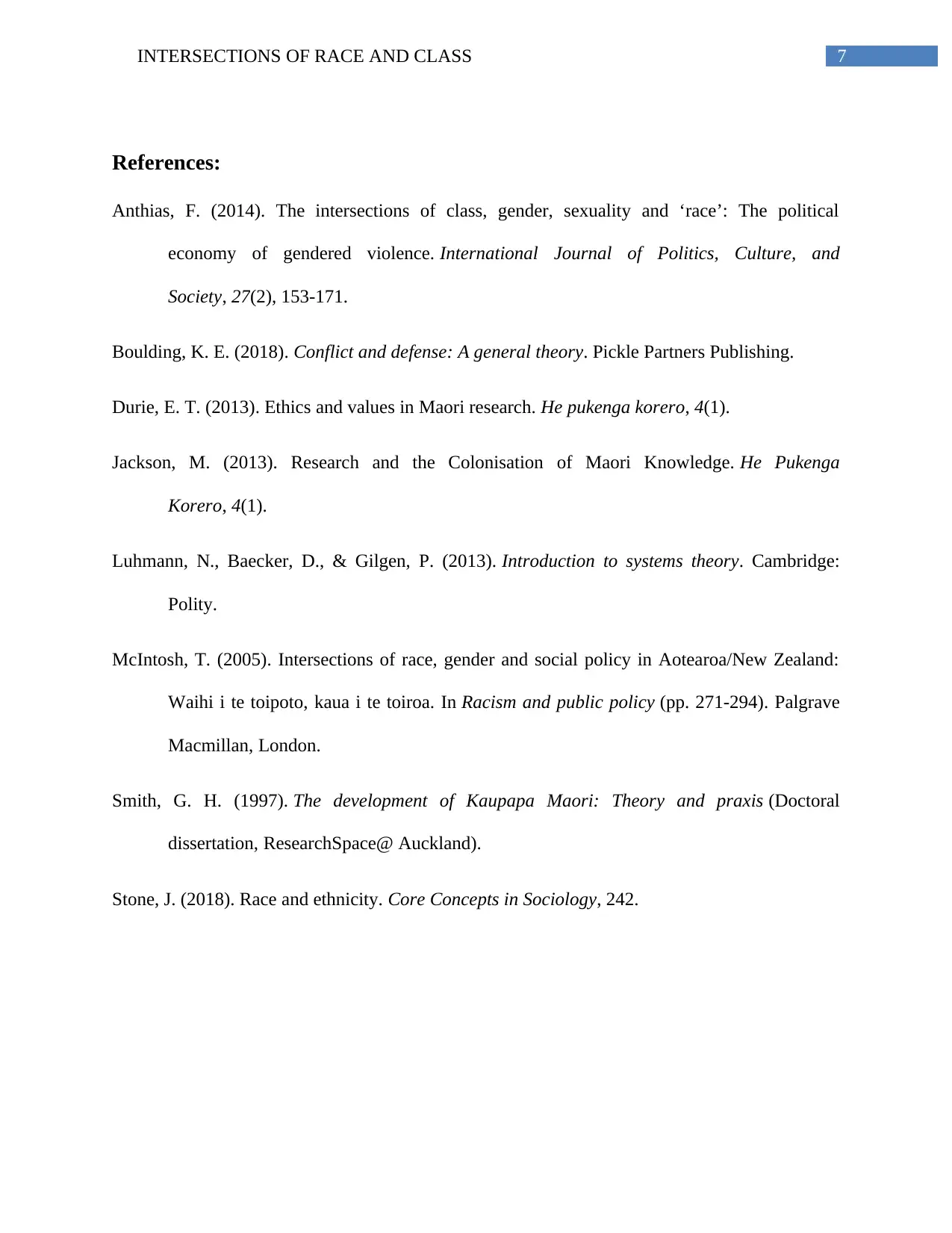
7INTERSECTIONS OF RACE AND CLASS
References:
Anthias, F. (2014). The intersections of class, gender, sexuality and ‘race’: The political
economy of gendered violence. International Journal of Politics, Culture, and
Society, 27(2), 153-171.
Boulding, K. E. (2018). Conflict and defense: A general theory. Pickle Partners Publishing.
Durie, E. T. (2013). Ethics and values in Maori research. He pukenga korero, 4(1).
Jackson, M. (2013). Research and the Colonisation of Maori Knowledge. He Pukenga
Korero, 4(1).
Luhmann, N., Baecker, D., & Gilgen, P. (2013). Introduction to systems theory. Cambridge:
Polity.
McIntosh, T. (2005). Intersections of race, gender and social policy in Aotearoa/New Zealand:
Waihi i te toipoto, kaua i te toiroa. In Racism and public policy (pp. 271-294). Palgrave
Macmillan, London.
Smith, G. H. (1997). The development of Kaupapa Maori: Theory and praxis (Doctoral
dissertation, ResearchSpace@ Auckland).
Stone, J. (2018). Race and ethnicity. Core Concepts in Sociology, 242.
References:
Anthias, F. (2014). The intersections of class, gender, sexuality and ‘race’: The political
economy of gendered violence. International Journal of Politics, Culture, and
Society, 27(2), 153-171.
Boulding, K. E. (2018). Conflict and defense: A general theory. Pickle Partners Publishing.
Durie, E. T. (2013). Ethics and values in Maori research. He pukenga korero, 4(1).
Jackson, M. (2013). Research and the Colonisation of Maori Knowledge. He Pukenga
Korero, 4(1).
Luhmann, N., Baecker, D., & Gilgen, P. (2013). Introduction to systems theory. Cambridge:
Polity.
McIntosh, T. (2005). Intersections of race, gender and social policy in Aotearoa/New Zealand:
Waihi i te toipoto, kaua i te toiroa. In Racism and public policy (pp. 271-294). Palgrave
Macmillan, London.
Smith, G. H. (1997). The development of Kaupapa Maori: Theory and praxis (Doctoral
dissertation, ResearchSpace@ Auckland).
Stone, J. (2018). Race and ethnicity. Core Concepts in Sociology, 242.
1 out of 8
Related Documents
Your All-in-One AI-Powered Toolkit for Academic Success.
+13062052269
info@desklib.com
Available 24*7 on WhatsApp / Email
![[object Object]](/_next/static/media/star-bottom.7253800d.svg)
Unlock your academic potential
Copyright © 2020–2025 A2Z Services. All Rights Reserved. Developed and managed by ZUCOL.





